#World Environment Day 2023
Explore tagged Tumblr posts
Text
youtube
#shoaptv#how to draw environmental day#environment day#environment day card#world environment day#environment day speech#environment day poster#environment day slogan#environment day drawing#world environment day 2021#world environment day 2023#best environment day craft#world environment day 2024#environment drawing#our environment day drawing#save environment day speech#world environment day craft#world environment day chart#june5th#tumulurirajendraprasad#Youtube
0 notes
Text
0 notes
Text

Happy World Environment Day to All
The Earth is like our home, and we must work hard to preserve it clean and green. Let's pledge to make the world a better place to live on World Environment Day!
#World Environment Day#Happy World Environment Day#World Environment Day 2023#Best Academy in Indore#Best Schools in Indore
1 note
·
View note
Text
World Environment Day : History & Significance
World environment day World Environment Day is celebrated annually on June 5th to raise awareness and encourage global action for the protection and preservation of our environment. It is one of the principal vehicles through which the United Nations stimulates worldwide awareness and action for the environment. Here is the history and significance of World Environment Day: History: World…

View On WordPress
#5june 2023#earth day#earth day 2023#environment#environment day quiz#environment day quiz 2022#environmental auditor#environmental consultant#environmental manager#fantastic kids#quiz on world environment day 2023#theme of world environment day 2023#world environment day#world environment day 2022 sweden#world environment day 2022 theme#world environment day 2023#world environment day 2023 quiz#world environment day 2023 theme#world environment day essay
0 notes
Text
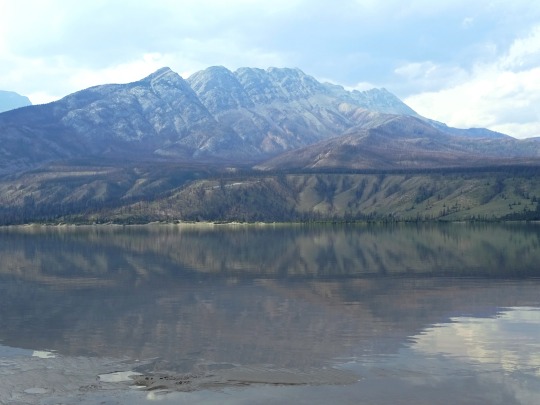
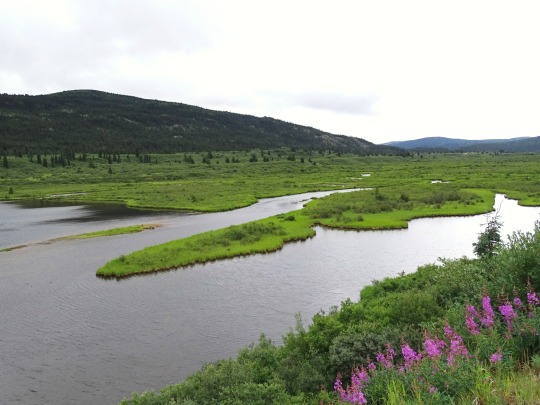



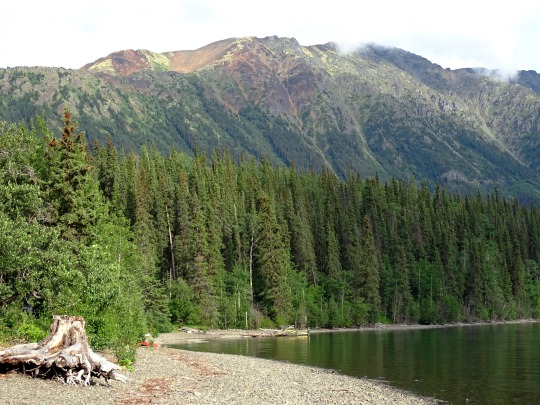
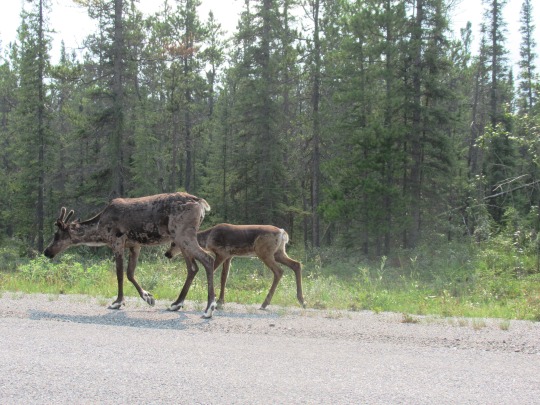




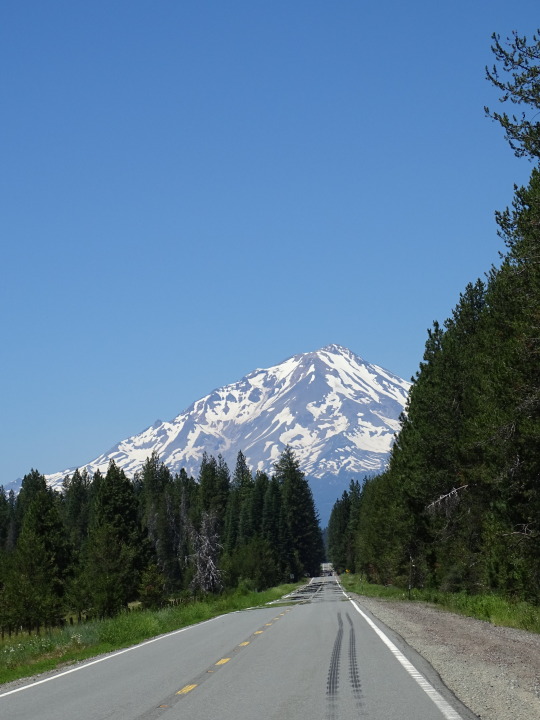
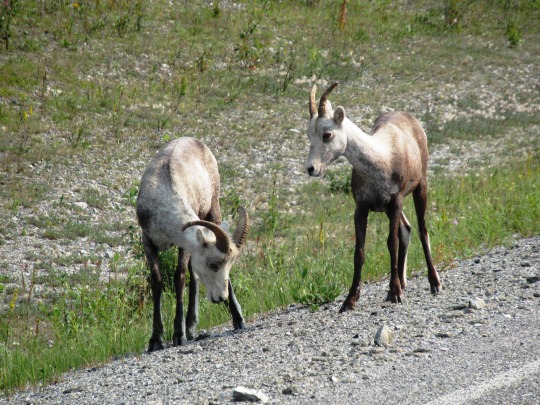




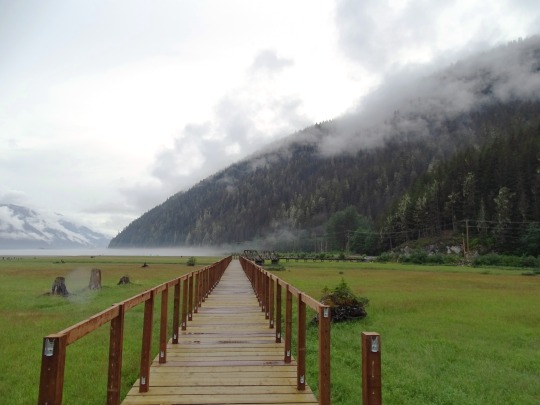
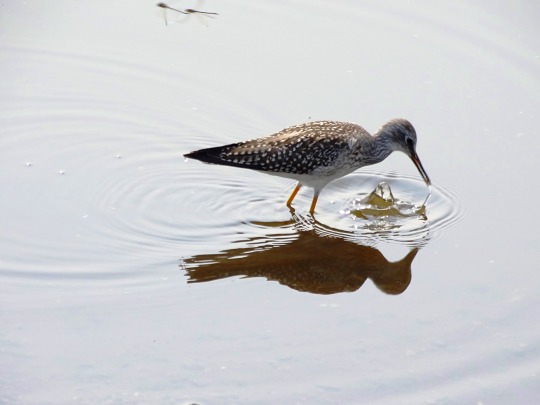
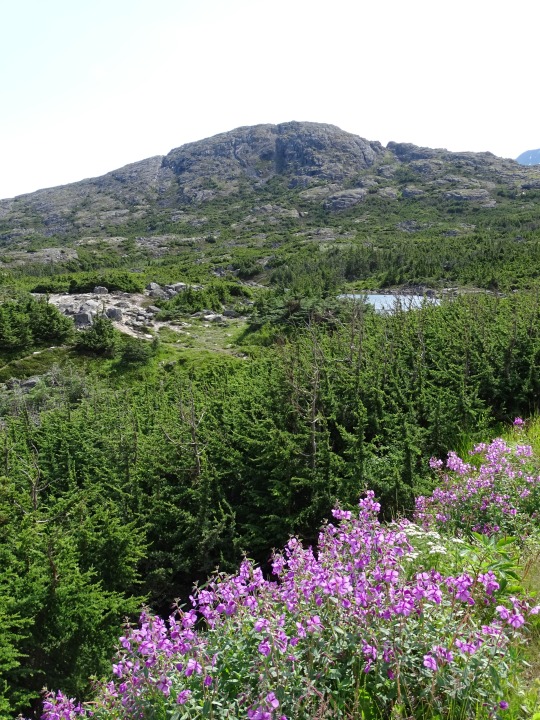



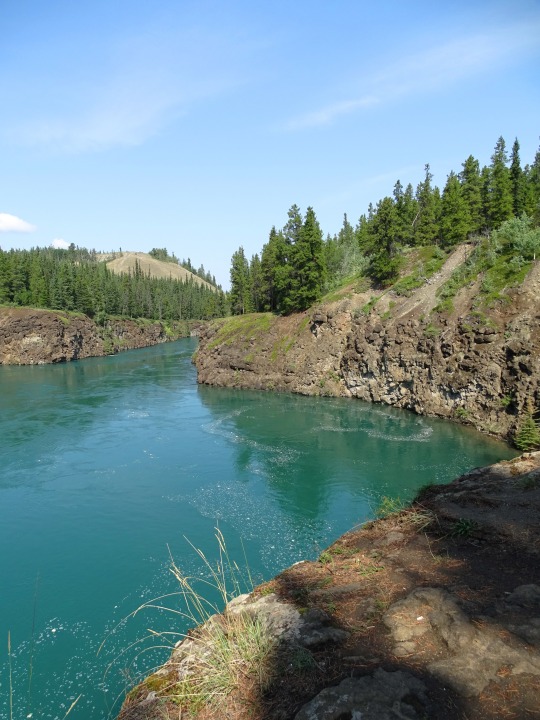

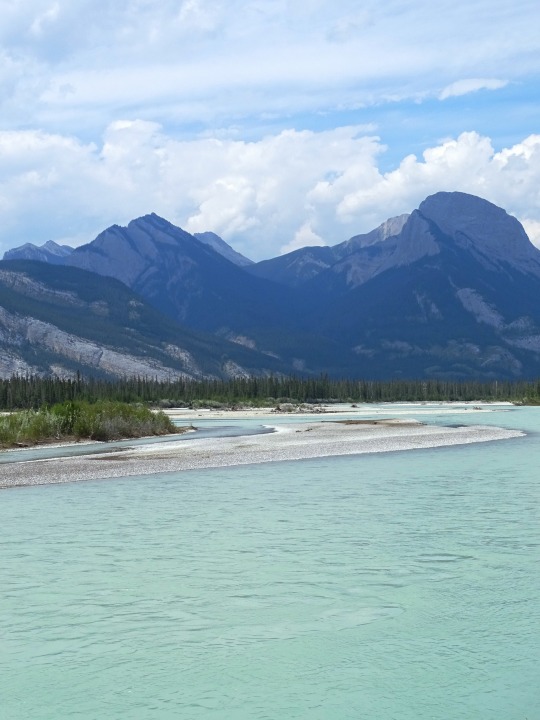

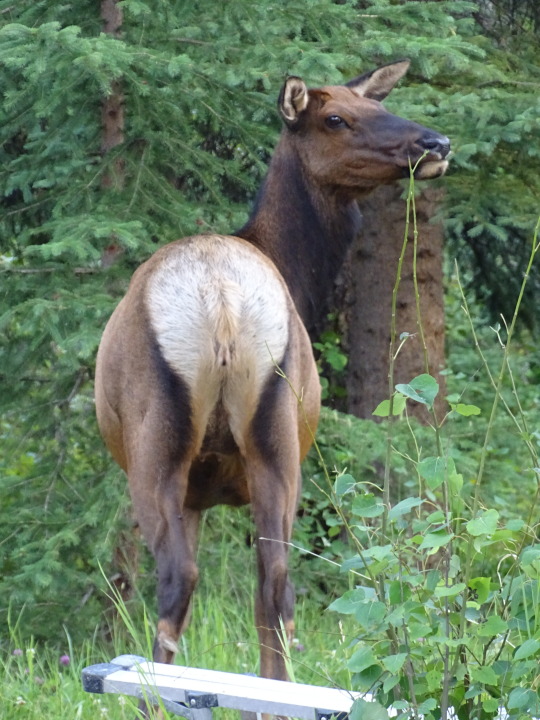
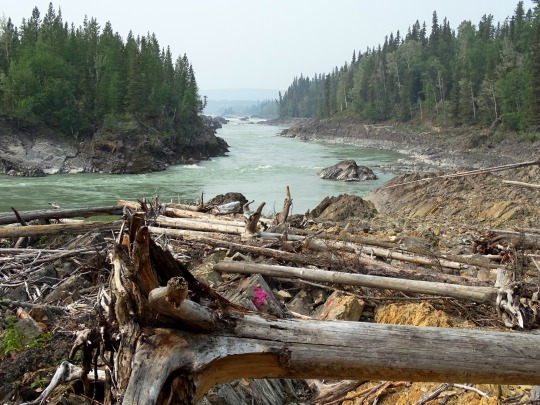
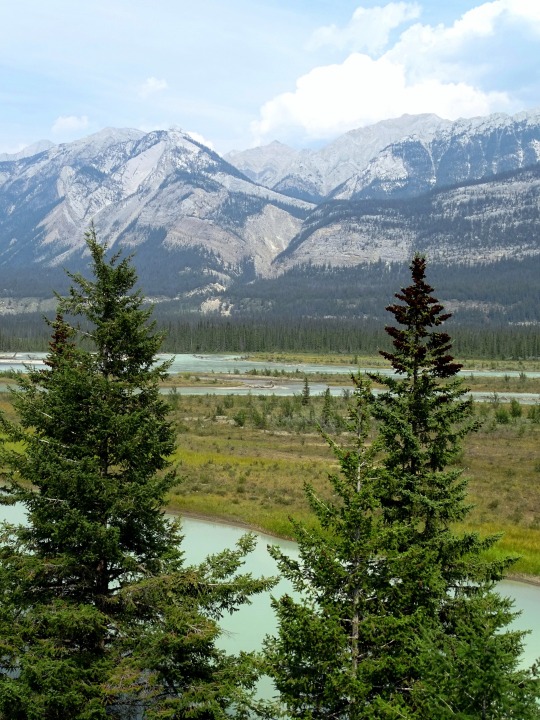
World Environment Day
World Environment Day urges all of us to protect our natural surroundings. The stunning facts? An estimated 7 million people die each year from causes related to air pollution, with a majority occurring in the Asia-Pacific region. This day, which falls on June 5, encourages worldwide activism. That means everything from littering to climate change. World Environment Day is both a global celebration and a platform for public outreach.
China, which now owns half the world’s electric vehicles and 99 percent of the world’s electric buses, hosted the 2019 event. “The country has demonstrated tremendous leadership in tackling air pollution domestically,” said Acting Head of UN Environment Joyce Msuya. “It can now help spur the world to greater action.” The UN first established World Environment Day in 1972.
When is World Environment Day 2024?
World Environment Day is observed on June 5 every year. Outside of our homes is the actual home we all live in, and preserving it for future generations is more crucial than ever.
History of World Environment Day
World Environment Day (WED) is one of the more unique and special holidays because of its history and its many firsts. It was created on the first day of the first-ever U.N. conference which focused on humans and how they interact with the environment.
However, this didn’t happen overnight. Sweden first suggested having such a conference to the U.N. way back in 1968. And in 1969, the U.N. agreed that after 3 years they would have a conference in Sweden that focused on environmental issues. Interestingly enough, the conference was led by Maurice Strong, a Canadian diplomat who worked in the oil and mineral industry, who also had a soft spot for the environment.
Finally, it all came together in 1972, after 4 years of preparations and $30,000,000 later. World leaders from around the world sat together to discuss how they can raise awareness to protect our environment — and it was then WED was made. Then 2 years later, the first-ever WED was celebrated with the slogan “Only One Earth.”
Ever since then, WED has been completely embraced by people everywhere, so much so that it’s even slowly creeping into pop culture (and we love it!) Celebrities around the world all encourage people, in their own unique way, to do their part and “ save the world”. Fan-favorites Leonardo DiCaprio and Meryl Streep are some of the many who constantly speak out about environmental awareness. So, it doesn’t matter if you’re a famous actor, an athlete or a student in college: gather your friends and spend a day outdoors doing fun activities towards preserving this beautiful planet. Believe us when we say, you’ll have a blast and feel so much better afterward.
World Environment Day timeline
1968 The Idea is Born
Sweden suggests to the UN to have a conference that is focused on the environment.
1972 First U.N Environmental Conference
Maurice Strong finally leads the discussions about marine pollution, human overpopulation, and global warming.
1974 A Dream Debut
The first World Environment Day is celebrated in Spokane, Washington.
2019 China Hosts World Environment Day
China raises awareness of the 7 million people who die annually from air pollution with the slogan 'Beat Air Pollution.'
Traditions of the Day
Sustainability and the protection of the environment are without a doubt among the most pressing issues we face in the world today. The core necessities of life all come from Mother Nature and, unfortunately, we take it for granted. World Environment Day encourages everyone from individuals to large-scale corporations to be more conscious of their impact on the environment.
A theme is observed every year. The theme for 2020 was ‘Biodiversity.’ Advocacy campaigns and calls for change are heavily promoted, all the while educating others to adopt healthy actions and break patterns that contribute to the degradation of the ecosystem. Just the simple act of switching off unnecessary lights has a tremendous effect. Exhibitions and events take place at educational institutions, with influential spokespeople in attendance.
By the Numbers
90 billion tons – the number of resources extracted from Earth every year.
7.8 billion – the number of people populating Earth.
4.1 billion – the number of consumers in the world.
5.6 billion – the number of consumers expected by 2030.
70% – the percentage of the world’s resources currently being overused.
2.12 billion tons – the number of waste dumped every year.
50 million tons – the number of e-waste produced every year.
$7.8 trillion – the value of the global production of synthetic chemicals.
2050 – the year when the world population is expected to be too big to feed.
2070 – the year when coral reefs are expected to be gone altogether.
World Environment Day FAQs
Is global warming real?
From the data gathered it seems so, and according to NASA, the debate is now moving from if humans are responsible for global warming to how is the best way to respond to the problem.
What fun activity can you do on World Environment Day?
Either by yourself or with a group of your friends or even family members, plant a sapling (young tree) and take a selfie with it. Don’t forget to post it on your social media with #SelfiewithSapling.
How often is World Environment Day celebrated?
Every year on June 5 World Environment Day is celebrated. The cool thing is, almost every year a new country hosts the holiday and since it was first celebrated 34 different cities in 25 countries have hosted this day.
How to Observe World Environment Day
Make a commitment to recycle
Plant a tree
Volunteer
It might seem like a basic tip, but are you really taking every possible opportunity to recycle? Next time you're thinking about throwing that piece of paper in the trash because a recycling bin isn't accessible, think twice. Holding a plastic container and too lazy to see if it's one of the biodegradable kinds? Open up your smartphone and look it up! Everyone's responsible for reducing greenhouse gas emissions — including you.
Trees absorb odors and pollutant gases (nitrogen oxides, ammonia, sulfur dioxide, and ozone) and filter particulates out of the air by trapping them on their leaves and bark. Placed strategically around a single-family home, they can cut summer air conditioning needs by up to 50 percent. By reducing the energy demand for cooling our houses, we reduce carbon dioxide and other pollution emissions from power plants.
Anyone can volunteer, and volunteering can make a difference to the whole community. Get out of your comfort zone by volunteering for the National Park Service, or stay local by volunteering at your farmers’ market. Any way you choose to participate, you'll feel the positive impact of getting out of the house and caring for the planet.
5 Interesting Facts About World Environment Day
Solar Panels
CO2 Vacuum Cleaner
The Ocean Cleanup
Plant-Based Plastic
Eco-Friendly Batteries
The largest solar farm, Yanchi Ningxia solar park in China, can provide up to 1 billion watts.
Developed in Switzerland in 2016, giant machines capture CO2 to clean the air we breathe.
Backed with $30 million and led by a 22-year-old, this company uses U-shaped screens to catch garbage in the ocean.
Created by an Indonesian company, it’s made from agricultural leftovers like corn, sugarcane, etc.
Developed in the Chalmers University of Technology in Sweden using upgraded aluminum.
Why World Environment Day is Important
It reconnects us to nature
It raises awareness
It encourages us to take action
Sometimes we forget just how much natural systems support our own well-being. But we're part of nature, and we depend on it. So today's the perfect occasion to go out and enjoy your country's national parks, and celebrate the vital relationship.
More and more people are starting to understand that we need to sustainably manage our planet's resources and ecosystems. However, that belief is far from universal. That's why World Environment Day is so important: it provides an occasion to raise awareness and teach friends and family that the physical environment is fragile and indispensable. But before you begin promoting environmental awareness in your own community, make sure that you have a thorough understanding of environmental issues yourself. There's always more to learn!
The environment has become increasingly polluted with contaminants and toxins, and these have a harmful impact on our health. They can cause respiratory diseases and cancer—and that's just for starters. By raising awareness of the issues with the air that sustains us, World Environment Day inspires us to do something about it and fix the environment we can't live without.
Source
#wood bison#elk#caribou#stone sheep#bighorn sheep#wildlife#Jasper National Park#Alberta#British Columbia#Yukon#Canada#Oregon#California#Rocky Mountains#summer 2023#travel#original photography#vacation#tourist attraction#landmark#landscape#USA#5 June#World Environment Day#WorldEnvironmentDay
4 notes
·
View notes
Text
I don't think most of us understand exactly the extent of devastation in Gaza. In the first month of this genocide alone, the Gaza Strip has been hit with firepower the equivalent of 2 nuclear bombs! Between October 2023 and April 2024, Israel has dropped approximately 70,000 tons of bombs on Gaza, surpassing the bombing of Dresden, Hamburg, and London combined during World War II! And Gaza is only 360km² big, which is 4 times smaller than London and 2.5 times smaller than Hiroshima. But Gaza has a very high population density of 5,500 people per square kilometer, which is higher than that of most cites, including London!
Israel has not stopped or slowed its attack on Gaza. Just 2 days ago, Israel has killed at least 36 people during an airstrike on Nuseirat Refugee camp. The building targeted is a residential block housing children, families and displaced people.
My friend Mahmoud (@mahmoudfamily7) has 17 family members in Nuseirat right now, including 10 children. In addition to all the attacks, they cannot buy basic necessities as items have risen to 8000% more expensive than usual, or even more! They have 3 infants with them, including a baby born only a few months ago. Mahmoud's sister is also still healing from the infects she got from giving birth in a polluted environment with no medical resources!
Vetted! Mahmoud's campaign is #3 on @/gaza-evacuation-funds vetted list here, #117 on @/gazavetters vetted list, vetted by bilal-salah0, and vetted by association!
Mahmoud has been fundraising since May, that's more than half a year now but his campaign is still stuck at 7%! They have received only 1 donation in the past 3 days! Right now they have only raised $5,285 CAD raised of $80K goal (equivalent to $3712 USD!), and that's after 7 months of fundraising! Please give them more support!
tagging for reach
@sporesgalaxy @ilovelifetbh @pigswithwings @certifiedsexed @tpwrtrmnky
@closet-keys @extremelycursedimages @medusadyke @punkitt-is-here @whatcoloristhatcat
@rickybabyboy @weirdmarioenemies @tamamita @beetledrink @apas-95
@sneez @rainy-fog @orphetoon @triptrippy @amygdalae @pointnclick
@psygull @mayonaisalspray @biomic @saccharinescorpion @bunniope
@lappyisgaming @miiilowo @bluerepository @kindaorangey @lorelune
@ramshackledtrickster @the-ballerina-battle @blazepandaartz @ccomilk @cowboyjimkirk
@8ball-wizard @aquariumgirls @butchcockiness2 @hotgirlmeg @uquizzs
@fandaniel @wozapi @the1312daysofchristmas @6oys @t4t4t
@grapejuicedragoon @some-pers0n @naggingatlas @shockwavesmassivetit @mahoushojoe
@opencommunion @palistani @3000s @soranatus @sevendeadlyyamis @000marie198 @beetlebongos @mevil
@prisonhannibal @genderdog @geekydragon @comrademango @amvs
@p0pp3t @t-800 @tethys-saturnalia @anghju @sniffingcinnamon
@sunnylittledragon @dyspunktional-leviathan @linkedsoul @jewfrogs
@balaclava-trismegistus @avi-wings @fleshdyk3 @innovatorbunny @truffleskies
@not-a-hawk @indignantdessertbirds @ropes3amthoughts @slagginbitch @rob-os-17
@virovac @misted-buttercup-enjoyer @shykino @saltycharacters @2bu
@strangestcase @darkmatterblade @turtletoria @murderbot @pretendingtobeaperson
@pikslasrce @omtai @carfuckerlynch @aristotels @toesuckingoctober
@bearie @lesbiandardevil @hjarta @doubleca5t @wuntrum
@hazem-khalil
---------------------------------------------------------------------------
@mahmoudfamily7, @mahmoudmaherfam, @mahmoudfamily, @mahmoudfamilyy, @mahmoufamilyyy, @mahmoufamilia, @mahmoudfamily1
1K notes
·
View notes
Photo

purever happy world environment day 2023, world environment day, pure water, save water, healthy water, purever water tanks
1 note
·
View note
Text
🌍🌊🌎🌱🌏
WORLD ENVIRONMENT DAY —
The United Nations designated 5 June as World Environment Day to highlight the protection and health of the environment as major issue; The degradation of the environment affects the well-being of peoples and economic development throughout the world.
.
💚💙
.
0 notes
Photo

Happy World Environment Day 2023.
0 notes
Text
What kind of bubble is AI?

My latest column for Locus Magazine is "What Kind of Bubble is AI?" All economic bubbles are hugely destructive, but some of them leave behind wreckage that can be salvaged for useful purposes, while others leave nothing behind but ashes:
https://locusmag.com/2023/12/commentary-cory-doctorow-what-kind-of-bubble-is-ai/
Think about some 21st century bubbles. The dotcom bubble was a terrible tragedy, one that drained the coffers of pension funds and other institutional investors and wiped out retail investors who were gulled by Superbowl Ads. But there was a lot left behind after the dotcoms were wiped out: cheap servers, office furniture and space, but far more importantly, a generation of young people who'd been trained as web makers, leaving nontechnical degree programs to learn HTML, perl and python. This created a whole cohort of technologists from non-technical backgrounds, a first in technological history. Many of these people became the vanguard of a more inclusive and humane tech development movement, and they were able to make interesting and useful services and products in an environment where raw materials – compute, bandwidth, space and talent – were available at firesale prices.
Contrast this with the crypto bubble. It, too, destroyed the fortunes of institutional and individual investors through fraud and Superbowl Ads. It, too, lured in nontechnical people to learn esoteric disciplines at investor expense. But apart from a smattering of Rust programmers, the main residue of crypto is bad digital art and worse Austrian economics.
Or think of Worldcom vs Enron. Both bubbles were built on pure fraud, but Enron's fraud left nothing behind but a string of suspicious deaths. By contrast, Worldcom's fraud was a Big Store con that required laying a ton of fiber that is still in the ground to this day, and is being bought and used at pennies on the dollar.
AI is definitely a bubble. As I write in the column, if you fly into SFO and rent a car and drive north to San Francisco or south to Silicon Valley, every single billboard is advertising an "AI" startup, many of which are not even using anything that can be remotely characterized as AI. That's amazing, considering what a meaningless buzzword AI already is.
So which kind of bubble is AI? When it pops, will something useful be left behind, or will it go away altogether? To be sure, there's a legion of technologists who are learning Tensorflow and Pytorch. These nominally open source tools are bound, respectively, to Google and Facebook's AI environments:
https://pluralistic.net/2023/08/18/openwashing/#you-keep-using-that-word-i-do-not-think-it-means-what-you-think-it-means
But if those environments go away, those programming skills become a lot less useful. Live, large-scale Big Tech AI projects are shockingly expensive to run. Some of their costs are fixed – collecting, labeling and processing training data – but the running costs for each query are prodigious. There's a massive primary energy bill for the servers, a nearly as large energy bill for the chillers, and a titanic wage bill for the specialized technical staff involved.
Once investor subsidies dry up, will the real-world, non-hyperbolic applications for AI be enough to cover these running costs? AI applications can be plotted on a 2X2 grid whose axes are "value" (how much customers will pay for them) and "risk tolerance" (how perfect the product needs to be).
Charging teenaged D&D players $10 month for an image generator that creates epic illustrations of their characters fighting monsters is low value and very risk tolerant (teenagers aren't overly worried about six-fingered swordspeople with three pupils in each eye). Charging scammy spamfarms $500/month for a text generator that spits out dull, search-algorithm-pleasing narratives to appear over recipes is likewise low-value and highly risk tolerant (your customer doesn't care if the text is nonsense). Charging visually impaired people $100 month for an app that plays a text-to-speech description of anything they point their cameras at is low-value and moderately risk tolerant ("that's your blue shirt" when it's green is not a big deal, while "the street is safe to cross" when it's not is a much bigger one).
Morganstanley doesn't talk about the trillions the AI industry will be worth some day because of these applications. These are just spinoffs from the main event, a collection of extremely high-value applications. Think of self-driving cars or radiology bots that analyze chest x-rays and characterize masses as cancerous or noncancerous.
These are high value – but only if they are also risk-tolerant. The pitch for self-driving cars is "fire most drivers and replace them with 'humans in the loop' who intervene at critical junctures." That's the risk-tolerant version of self-driving cars, and it's a failure. More than $100b has been incinerated chasing self-driving cars, and cars are nowhere near driving themselves:
https://pluralistic.net/2022/10/09/herbies-revenge/#100-billion-here-100-billion-there-pretty-soon-youre-talking-real-money
Quite the reverse, in fact. Cruise was just forced to quit the field after one of their cars maimed a woman – a pedestrian who had not opted into being part of a high-risk AI experiment – and dragged her body 20 feet through the streets of San Francisco. Afterwards, it emerged that Cruise had replaced the single low-waged driver who would normally be paid to operate a taxi with 1.5 high-waged skilled technicians who remotely oversaw each of its vehicles:
https://www.nytimes.com/2023/11/03/technology/cruise-general-motors-self-driving-cars.html
The self-driving pitch isn't that your car will correct your own human errors (like an alarm that sounds when you activate your turn signal while someone is in your blind-spot). Self-driving isn't about using automation to augment human skill – it's about replacing humans. There's no business case for spending hundreds of billions on better safety systems for cars (there's a human case for it, though!). The only way the price-tag justifies itself is if paid drivers can be fired and replaced with software that costs less than their wages.
What about radiologists? Radiologists certainly make mistakes from time to time, and if there's a computer vision system that makes different mistakes than the sort that humans make, they could be a cheap way of generating second opinions that trigger re-examination by a human radiologist. But no AI investor thinks their return will come from selling hospitals that reduce the number of X-rays each radiologist processes every day, as a second-opinion-generating system would. Rather, the value of AI radiologists comes from firing most of your human radiologists and replacing them with software whose judgments are cursorily double-checked by a human whose "automation blindness" will turn them into an OK-button-mashing automaton:
https://pluralistic.net/2023/08/23/automation-blindness/#humans-in-the-loop
The profit-generating pitch for high-value AI applications lies in creating "reverse centaurs": humans who serve as appendages for automation that operates at a speed and scale that is unrelated to the capacity or needs of the worker:
https://pluralistic.net/2022/04/17/revenge-of-the-chickenized-reverse-centaurs/
But unless these high-value applications are intrinsically risk-tolerant, they are poor candidates for automation. Cruise was able to nonconsensually enlist the population of San Francisco in an experimental murderbot development program thanks to the vast sums of money sloshing around the industry. Some of this money funds the inevitabilist narrative that self-driving cars are coming, it's only a matter of when, not if, and so SF had better get in the autonomous vehicle or get run over by the forces of history.
Once the bubble pops (all bubbles pop), AI applications will have to rise or fall on their actual merits, not their promise. The odds are stacked against the long-term survival of high-value, risk-intolerant AI applications.
The problem for AI is that while there are a lot of risk-tolerant applications, they're almost all low-value; while nearly all the high-value applications are risk-intolerant. Once AI has to be profitable – once investors withdraw their subsidies from money-losing ventures – the risk-tolerant applications need to be sufficient to run those tremendously expensive servers in those brutally expensive data-centers tended by exceptionally expensive technical workers.
If they aren't, then the business case for running those servers goes away, and so do the servers – and so do all those risk-tolerant, low-value applications. It doesn't matter if helping blind people make sense of their surroundings is socially beneficial. It doesn't matter if teenaged gamers love their epic character art. It doesn't even matter how horny scammers are for generating AI nonsense SEO websites:
https://twitter.com/jakezward/status/1728032634037567509
These applications are all riding on the coattails of the big AI models that are being built and operated at a loss in order to be profitable. If they remain unprofitable long enough, the private sector will no longer pay to operate them.
Now, there are smaller models, models that stand alone and run on commodity hardware. These would persist even after the AI bubble bursts, because most of their costs are setup costs that have already been borne by the well-funded companies who created them. These models are limited, of course, though the communities that have formed around them have pushed those limits in surprising ways, far beyond their original manufacturers' beliefs about their capacity. These communities will continue to push those limits for as long as they find the models useful.
These standalone, "toy" models are derived from the big models, though. When the AI bubble bursts and the private sector no longer subsidizes mass-scale model creation, it will cease to spin out more sophisticated models that run on commodity hardware (it's possible that Federated learning and other techniques for spreading out the work of making large-scale models will fill the gap).
So what kind of bubble is the AI bubble? What will we salvage from its wreckage? Perhaps the communities who've invested in becoming experts in Pytorch and Tensorflow will wrestle them away from their corporate masters and make them generally useful. Certainly, a lot of people will have gained skills in applying statistical techniques.
But there will also be a lot of unsalvageable wreckage. As big AI models get integrated into the processes of the productive economy, AI becomes a source of systemic risk. The only thing worse than having an automated process that is rendered dangerous or erratic based on AI integration is to have that process fail entirely because the AI suddenly disappeared, a collapse that is too precipitous for former AI customers to engineer a soft landing for their systems.
This is a blind spot in our policymakers debates about AI. The smart policymakers are asking questions about fairness, algorithmic bias, and fraud. The foolish policymakers are ensnared in fantasies about "AI safety," AKA "Will the chatbot become a superintelligence that turns the whole human race into paperclips?"
https://pluralistic.net/2023/11/27/10-types-of-people/#taking-up-a-lot-of-space
But no one is asking, "What will we do if" – when – "the AI bubble pops and most of this stuff disappears overnight?"

If you'd like an essay-formatted version of this post to read or share, here's a link to it on pluralistic.net, my surveillance-free, ad-free, tracker-free blog:
https://pluralistic.net/2023/12/19/bubblenomics/#pop

Image: Cryteria (modified) https://commons.wikimedia.org/wiki/File:HAL9000.svg
CC BY 3.0 https://creativecommons.org/licenses/by/3.0/deed.en
--
tom_bullock (modified) https://www.flickr.com/photos/tombullock/25173469495/
CC BY 2.0 https://creativecommons.org/licenses/by/2.0/
4K notes
·
View notes
Text
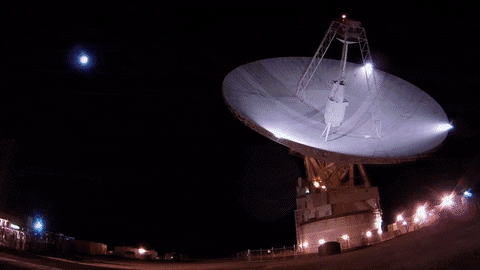
9 Out-of-This-World Moments for Space Communications & Navigation in 2023
How do astronauts and spacecraft communicate with Earth?
By using relay satellites and giant antennas around the globe! These tools are crucial to NASA’s space communications networks: the Near Space Network and the Deep Space Network, which bring back science and exploration data every day.
It’s been a great year for our space communications and navigation community, who work to maintain the networks and enhance NASA’s capabilities. Keep scrolling to learn more about our top nine moments.

The SpaceX Falcon 9 rocket carrying the Dragon spacecraft lifts off from Launch Complex 39A at NASA's Kennedy Space Center in Florida on Thursday, Nov. 9, 2023, on the company's 29th commercial resupply services mission for the agency to the International Space Station. Liftoff was at 8:28 p.m. EST.
1. In November, we launched a laser communications payload, known as ILLUMA-T, to the International Space Station. Now, ILLUMA-T and the Laser Communications Relay Demonstration (LCRD) are exchanging data and officially complete NASA’s first two-way, end-to-end laser relay system. Laser communications can send more data at once than traditional radio wave systems – think upgrading from dial-up to fiber optic internet. ILLUMA-T and LCRD are chatting at 1.2 gigabits per second (Gbps). At that rate, you could download an average movie in under a minute.

NASA’s InSight lander captured this selfie on Mars on April 24, 2022, the 1,211th Martian day, or sol, of the mission.
2. Data analyzed in 2023 from NASA’s retired InSight Mars lander provided new details about how fast the Red Planet rotates and how much it wobbles. Scientists leveraged InSight’s advanced radio technology, upgrades to the Deep Space Network, and radio signals to determine that Mars’ spin rate is increasing, while making the most precise measurements ever of Mars’ rotation.
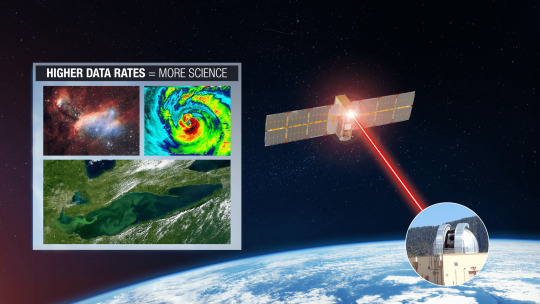
TBIRD is demonstrating a direct-to-Earth laser communications link from low Earth orbit to a ground station on Earth.
3. We set a new high record! The TeraByte InfraRed Delivery (TBIRD) payload – also demonstrating laser communications like ILLUMA-T and LCRD – downlinked 4.8 terabytes of data at 200 Gbps in a single 5-minute pass. This is the highest data rate ever achieved by laser communications technology. To put it in perspective a single terabyte is the equivalent of about 500 hours of high-definition video.
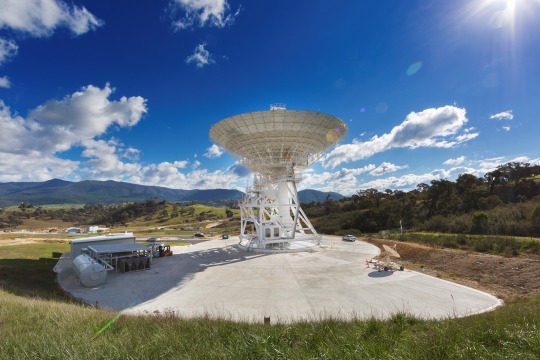
A 34-meter (112-foot) wide antenna at Canberra Deep Space Communications Complex near Canberra, Australia.
4. This year we celebrated the Deep Space Network’s 60th anniversary. This international array of antennas located at three complexes in California, Spain, and Australia allow us to communicate with spacecraft at the Moon and beyond. Learn more about the Deep Space Network’s legacy and future advancements.
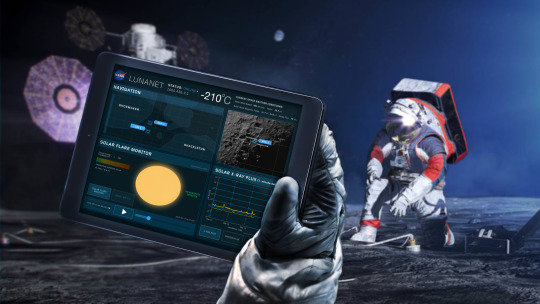
An illustration of the LunaNet architecture. LunaNet will bring internet-like services to the Moon.
5. We are bringing humans to the Moon with Artemis missions. During expeditions, astronauts exploring the surface are going to need internet-like capabilities to talk to mission control, understand their routes, and ensure overall safety. The space comm and nav group is working with international partners and commercial companies to develop LunaNet, and in 2023, the team released Draft LunaNet Specification Version 5, furthering development.
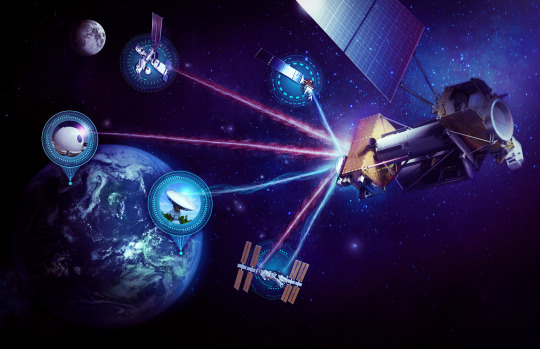
The High-Rate Delay Tolerant Networking node launched to the International Space Station in November and will act as a high-speed path for data.
6. In addition to laser communications, ILLUMA-T on the International Space Station is also demonstrating high-rate delay/disruption tolerant networking (HDTN). The networking node is showcasing a high-speed data path and a store-and-forward technique. HDTN ensures data reaches its final destination and isn’t lost on its path due to a disruption or delay, which are frequent in the space environment.

The Communications Services Project (CSP) partners with commercial industry to provide networking options for future spaceflight missions.
7. The space comm and nav team is embracing the growing aerospace industry by partnering with commercial companies to provide multiple networking options for science and exploration missions. Throughout 2023, our commercialization groups engaged with over 110 companies through events, one-on-one meetings, forums, conferences, and more. Over the next decade, NASA plans to transition near-Earth services from government assets to commercial infrastructure.
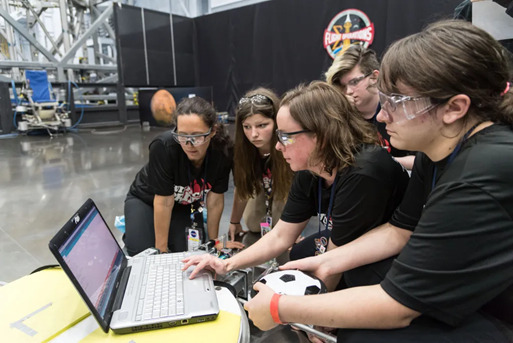
Middle and high school students solve a coding experiment during NASA's Office of STEM Engagement App Development Challenge.
8. Every year, NASA’s Office of STEM Engagement sponsors the App Development Challenge, wherein middle and high school students must solve a coding challenge. This year, student groups coded an application to visualize the Moon’s South Pole region and display information for navigating the Moon’s surface. Our space communications and navigation experts judged and interviewed students about their projects and the top teams visited NASA’s Johnson Space Center in Houston!
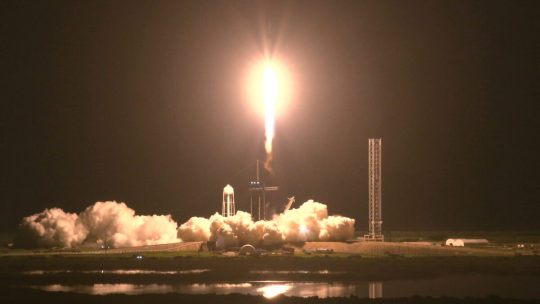
A SpaceX Falcon 9 rocket soars upward after liftoff at the pad at 3:27 a.m. EDT on Saturday, Aug. 26, from Kennedy Space Center’s Launch Complex 39A in Florida carrying NASA’s SpaceX Crew-7 crew members to the International Space Station. Aboard SpaceX’s Dragon spacecraft are NASA astronaut Jasmin Moghbeli, ESA (European Space Agency) astronaut Andreas Mogensen, JAXA (Japan Aerospace Exploration Agency) astronaut Satoshi Furukawa, and Roscosmos cosmonaut Konstantin Borisov.
9. The Near Space Network supported 19 launches in 2023! Launches included Commercial Crew flights to the International Space Station, science mission launches like XRISM and the SuperBIT balloon, and many more. Once in orbit, these satellites use Near Space Network antennas and relays to send their critical data to Earth. In 2023, the Near Space Network provided over 10 million minutes of communications support to missions in space.
Here’s to another year connecting Earth and space.
Make sure to follow us on Tumblr for your regular dose of space!
1K notes
·
View notes
Text
— Recent giant anteater sightings in Rio Grande do Sul state indicate the species has returned to southern Brazil, where it had been considered extinct for more than a century.
— Experts concluded that the giant anteater ventured across the border from the Iberá Park in northeastern Argentina where a rewilding project has released around 110 individuals back into the habitat.
— The sightings emphasize the importance of rewilding projects, both to restore animal populations in specific regions and help ecosystems farther afield.
— Organizations across Brazil are working to protect and maintain current giant anteater populations, including rallying for safer highways to prevent wildlife-vehicle collisions that cause local extinctions.
Playing back hours of footage from a camera trap set in Espinilho State Park in the south of Brazil in August 2023, Fábio Mazim and his team banked on possible sightings of the maned wolf or the Pantanal deer and had their fingers crossed for a glimpse of a Pampas cat (Leopardus pajeros), one of the most threatened felines in the world.
What they didn’t expect to see was an animal long presumed extinct in the region. To their surprise, the unmistakable long snout and bushy tail of a giant anteater ambled into shot.
"We shouted and cried when we saw it,” the ecologist from the nonprofit Pró-Carnívoros Institute told Mongabay. “It took a few days to grasp the importance of this record. A sighting of a giant anteater was never, ever expected.”
Last seen alive in the southwest of the Rio Grande do Sul state in 1890, the giant anteater (Myrmecophaga tridactyla) has since been spotted 11 times since August 2023, although the scientists are unsure whether it’s the same one or different individuals. However, the sightings confirm one clear fact: The giant anteater is back.
It's a huge win for the environment. Giant anteaters play an important role in their ecosystems, helping to control insect numbers, create watering holes through digging and are prey for big cats such as jaguars and pumas.
The habitat of the giant anteater stretches from Central America toward the south cone of Latin America.
Its conservation status is “vulnerable,” although it is considered extinct in several countries, including El Salvador, Guatemala and Uruguay, as well as specific regions such as the states of Rio de Janeiro, Espirito Santo, Santa Catarina and (until now) Rio Grande do Sul in Brazil and the Cordoba and Entre Rios regions in Argentina.
In the last six months, the giant anteater was spotted on camera 11 times in the Espinilho State Park in the state of Rio Grande do Sul in Brazil. It was the first time in 130 years that the species has been seen alive there.
Yet not only is it a triumph for conservationists to see these animals returning to Brazilian biomes, it’s also a surprising mark of success for a rewilding program about 150 kilometers (93 miles) away in neighboring Argentina.
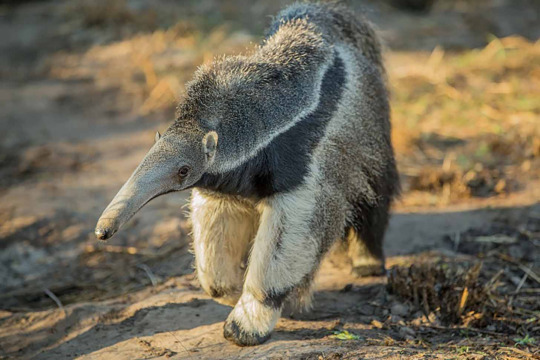
Rewilding Argentina’s biomes
Iberá National Park in Corrientes province in northeastern Argentina is a 758,000-hectare (1.9 million-acre) expanse of protected land comprising a part of the Iberá wetlands with its swaths of grasslands, marshes, lagoons and forests. The region was once home to just a handful of giant anteaters after habitat loss, hunting and vehicle collisions decimated the population.
Since 2007, the NGO Rewilding Argentina, an offspring of the nonprofit Tompkins Conservation, has been reintroducing the species back to the area, most individuals being orphaned pups rescued from vehicle collisions or poaching.
So far, they have released 110 giant anteaters back into the wild. Nowadays, several generations inhabit the park, transforming it from “a place of massive defaunation to abundance,” Sebastián Di Martino, director of conservation for Rewilding Argentina, was quoted as saying in an official statement.
The project has been so successful that the giant anteaters appear to be venturing farther afield and moving to new territories beyond national borders, such as Espinilho State Park in Brazil’s Rio Grande do Sul region...
Experts now hope that a giant anteater population can reestablish itself naturally in Espinilho State Park without the need for human intervention.
“The giant anteater returning to Rio Grande do Sul shows the success of the work done in Argentina and how it’s viable, possible and important to do rewilding and fauna reintroduction projects,” Mazim said. “It is also an indication that the management of conservation units and also the agricultural areas of the ecosystems are working,” he added. “Because if large mammals are coming from one region and settling in another, it is because there is a support capacity for them. It is an indication of the health of the environment.”
-via GoodGoodGood, via May 25, 2024
#anteater#giant anteater#brazil#brasil#argentina#rewilding#conservation#conversation news#nature#biodiversity#environment#ecosystem#ecology#good news#hope
617 notes
·
View notes
Text
Beckham II: 3 Nerves
The third part is finally here! I hope you enjoy.
Masterlist can be found here.

9th February 2023
“Breaking news this lunch time, Sarina Weigman had named her squad for the Arnold Clark cup and included in the squad for the first time in nearly 4 years is Y/N Beckham.” England squads weren’t typically breaking news on the main news channels but this was no ordinary squad announcement. “Widely considered as one of the best players on the planet, Beckham has not been including in an England squad since the 2019 World Cup and her return dominated the press conference.”
Squad announcement press conferences are usually comminated by a few stories, the surprise inclusions, the ones who don’t quite make the cut. However when the list was read out it was immediately clear what all the questions would be about today as the eyes of world football turned to Sarina.
“Sarina can you tell us more about Beckham’s inclusion? Why has this decision been taken now after 4 years?”
“I know you’re all probably very interested in that so I’ll try and answer all of your questions. This hasn’t been a simple process for either party, I’d be lying if I said I hadn’t been watching her since I became England manager but it’s not that simple and we had to respect the fact that Y/N did not want to be called up. Over the past few weeks I’ve been working closer with her and we’ve agreed that now is the right time to see if we can make progress.”
“The squad has changed a lot since then but there are still players who would were in the squad in 2019, have you spoken to them about this?”
“I have not, I’d like to think that all players support each other and I know my players well enough to know that they will do all they can to make Y/N feel welcome in this environment both on and off the pitch.”
“Do you have any concerns around her desire to play for England and play for the badge. Will she have lost that fight in the past four years?”
“I can not prove that to you and I guess none of us will know the answer until she plays for England again but I would not pick any player I had those concerns about. I’ve watcher her play a lot for Barcelona and over this past year especially I’ve seen a freedom to her play. I just hope that we can all see that side of her in an England shirt.”
“David, were you shocked when the announcement was made?”
“I mean obviously we spoke about prior to the announcement but when she told me I wasn’t exactly shocked. It just annoyed me that people questioned her mentally because she is so strong now.”
…..
Everyone could tell you were anxious. Since the announcement on Thursday you’d been quieter than usual in training, your usual sweet laughter which your teammates loved had been replaced by a strained giggle and they could see you’d been putting pressure on yourself in every department.
Everything had to be perfect.
In the four days since your decision had been made public you’d received support from all your teammates but you could see they were also worried. Many of them had been here when you joined, they’d seen the aftermath and many of them had been your shoulder to lean on for months after.
Many of them watched on now as you retreated into your room, barely giving a second glance to the games currently taking place in the dining room, a tradition you were a usual member of the night before an away game.
Alexia and Mapi had noticed the changes just like everyone else, the three of you had a strong connection both on and off the pitch. Alexia had become an older sister figure to you and Mapi was your platonic soul mate. They knew your habits unlike anyone else and when the notebook you used for anxious tattoo scribblings had been out the entire journey to Mallorca it was clear your mind was elsewhere.
“You grab the pillows.”
“I’ll grab the blankets.”
The two of them scurried off to their own rooms, finding their entrusted items before meeting back at the door which they knew you would be behind. You wouldn’t have gone outside, your shy nature meant you struggled to have confidence in new cities, preferring to explore with others rather than alone as the sun went down.
Alexia knocked on the door, a moment of panic striking as they thought you weren’t going to answer before the door creaked open. Your wide-eyed figure stood in the crack, still in the tracksuit you’d travelled in rather than pyjamas.
“What’s going on?” The tree of you quite often spent the nights in each other’s hotel rooms, though those meetings were usually pre-planned.
Only you knew from the worried expressions on their faces this wasn’t a call to watch the latest film that had been released. “We’re worried about you.”
“I’m fine.”
You should have known that answer was never going to satisfy them. “Please can we come in.”
It wasn’t even worth trying to persuade them, not really. “Sure.” They couldn’t miss the sigh you let out as the door swung open. “Make yourself comfy.”
In the matter of minutes you’d gone from sprawling over the double bed alone to shuffling between the two players, being welcomed into the arms of Alexia as the three of you shuffled under the duvet.
“We’re worried about you.” MarÍa admitted, smoothing down the hair draped around your face. “What’s going on?”
“Nothing.”
“Are you sure because I bet if we looked in that notepad we’d find more anxious doodles than before. You’ve barely spoken two words to anyone since the news broke out.”
“I read an article-“
“Didn’t I tell you to stop that.” Alexia scolded you. “Those journalists don’t know anything about you.”
“But they don’t know that.” You argued back. “They’ll be reading about how ‘cocky’ I am on and off the pitch, how I flaunt my money, how I think I ‘own the team’.”
“If they believe that then they really have no eyes. Then they’ll see how you’re one of the shiest players on the team, they’ll learn how you could live in mansion but donate so much money to charity, they’ll see how much you work on the team as a whole. You do everything for football and they need to see that.”
“If they don’t love the person they’ll come to know then that’s on them.” Alexia agreed with her.
“Are you sure this isn’t about a certain blonde centre back?” MarÍa teasingly questioned you. “Maybe this isn’t about you being nervous about the articles and more about going into gay panic around Miss Williamson.”
“I told you that in confidence that you’d never bring it up again.” It was true, a few years ago you had confided in the two of them that you used to have a small (very large) crush on Leah at the time.
“And I’m tired of you being the third wheel in our flat, you’ve rejected every opportunity for me to set you up with one of my friends so now I have to think that it’s because you’re still pining for the girl.”
“I’m not pining for anyone, it was a stupid crush which has gone in the four years that I haven’t spoken to the girl.”
“Would you like to speak to her again?” Alexia asked.
“I mean obviously I’m going to have to, she’s the captain of the team.”
“Message her now.”
“No.”
“Why not?” I could only think of a million reasons why I wasn’t about to do that.
“Because like I said, I haven’t spoken to her in nearly four years and it would be weird for me to just message her the night before we see each other again.”
“So lets role play it then, you walk into the hotel tomorrow and she’s there, what are you going to say?” Alexia asked the question you’ve been asking yourself all week.
“Hi.”
Both of them looked like they wanted to tear out both their own and your hair. “Ok you can’t just say that.”
“What else do you want me to say?”
“How are you? Ask her about her life?”
“You want me to speak to the girl for the first time in years and ask her basically how she’s been since we went from speaking every day to unfollowing each other on social media and avoiding any chance of meeting since then.” You needed better friends in situations like this. “I’m not going heavy on our first conversation.”
“You will need to talk about.”
“I know but it’s not just her I need to have that conversation with, I was close with a lot of them and now I’m not. They should be just as involved in that conversation as Leah is.”
“Maybe you could design her a little tattoo, something like ‘I love Y/N’ on her forehead.” MarÍa teased you. “Matches your ‘I love Leah’ on your chest.”
“Shut up, just so you know I’ll never stop cockblocking you and Ingrid, I’ll be round for tea when I get back.”
“Bonnie told me she wants to live with me all the time by the way, said something about her mum abandoning her.”
“Fuck off MarÍa.”
….
The first person to reach out to you wasn’t exactly someone you expected. Mary Earps wasn’t exactly in your friendship group back in 2019, though because she was a part of that squad she was one of the players who you unfollowed in the following unfortunate events. You definitely therefore were not expecting to see her name pop up as you made your way through the airport, heading out to the car which would take you back to your parents’ house before you headed to the team hotel later on in the evening.
@1maryearps: See you later mate, we can’t wait to have you back x
Your emotions were so all over the place that maybe you should have expected this simple message to bring tears to your eyes. Maybe that meant you’d have at least one person on your side tonight.
You spent most of the meal with parents and siblings trying to do anything to avoid the thoughts about what was happening tonight coming back. You spoke to Harper about her homework, Cruze about his latest holiday and Romeo about his girlfriend. Brooklyn could almost sense your nervousness and kept up the conversation, which was all fine until you had to leave.
They knew how big this moment was and each gave you an individual goodbye before you got back into the car. As much as you would have liked to have taken your dad’s offer to drive you, this was all about being normal and being drove by David Beckham didn’t really give off that vibe.
You’d made this drive a million times before, only this time it seemed to take half the time and before you knew it the doors to St George’s Park were in view.
The only person in view was a single man holding a video camera, obviously preparing for the players’ arrivals This was hard and yet you knew this was probably the easiest step, he didn’t know you. You got out from the car, flashing a small smile to the camera as it trained on your every move, making sure to say a thank you to the driver, you turned to head inside.
“How are you feeling Y/N?” The camera man asked.
“Excited.” You couldn’t exactly tell him you were shaking inside. “I can’t wait to be back with this amazing team.”
“Two goals from you today….”
“All thanks to my teammates.” It was only the truth, you were basically set up for both goals by Aitana, you couldn’t do anything but put them in the back of the net.
“Good luck.”
“Thank you very much.”
If you were known for one thing it would be your punctuality, in fact you almost had a fear of being late. Maybe you’d done it on purpose this time to avoid greeting teammates in front of the camera but you were the first here judging by the table in the reception area being full of keys.
“Y/N it’s good to finally meet you in person.” Anja, one of the members of the England management team greeted you. “I hope you’re feeling well.”
“I’m glad to be here,” You settled for that. “I can’t wait to get back on that pitch now.”
“Well we’re glad to have you here. Here’s your key, we’ll meet in the dining area for a quick debrief at 8 and then you’ll have the night to yourself. Training schedules for the week are in your key pack.”
“Thank you.”
This place hadn’t changed one bit, from the entrance all the way up to your rooms you could trace the steps without even looking. You could hear noise out in the corridor but you stayed put, waiting for the clock to tick to 7:50 before making your way downstairs. With it being ten minutes early no one was there but Sarina and the coaching staff. Could this technically count as your first impression to them?
Their eyes trained on you as you entered the room. “Hey, thank you once again.”
“Stop saying thank you, this is all on you.” Sarina instructed, giving you a firm yet welcoming hug, an action which was repeated by the others. “Go and take a seat.”
“Thank-“ Maybe not. “Ok Sarina.”
You didn’t really know what to expect from the others, the squad was definitely a mixture of youth and experience. However even some of the more established players like Alessia and Ella were unknown to you on a personal level.
Thankfully maybe the first ones in were some of the younger players, Jess Park and Ebony Salmon were both the epitome of excitement as they entered the room saying a quick hello to the staff before slightly pausing when they found me sat on the first row.
“Hi.” You knew it was on you to make the effort. “It’s nice to meet you both.”
“Nice to meet you too.” Jess said taking the seat next to me. “You’re killing it at Barcelona.”
“Thank you, I’ve enjoyed watching you play this season. You’ll be an asset at city when you return.” You loved studying young players and watching their development. Jess was no difference in that, plus it helped to build up that connection on the team.
The volume in the room increased as more players entered. Some like Laura Coombs and Katie Zelem gave you a quick smile before taking their seats, other youngsters gave you a quick welcome.
The first real re-introduction you had was when Millie and Rachel entered, your eyes instantly connecting and it was Rachel who led the two of them over. You had always loved the two of them and almost let out a sigh of relief when they both greeted you with hugs, repeating how glad they were to see you. Lucy and Jordan followed suit, the two of them messing about and pulling you into a tight hug before taking their seats.
It was however the final people to enter the room that you were the most nervous about. Maybe you should have been thankful that when Keira, Georgia and Leah entered the room the meeting was about to start and all you could do was send a glancing look their way before Sarina had eyes on her.
She went through the logistics, just like happens every time before she got into the depths of the squad. “It would seem like this is the squad for reintroducing yourself. Laura hasn’t been with us since 2020 and Y/N in 2019. We just want everyone to remember that they’re here for a reason and we all play for England, we’re all a team.”
You blocked everything else out, vaguely scribbling down on your phone some notes about the timings and rooms you were needed in but it was all a bit of a blur. You took your time at the end speaking to some of the other girls, no-one seemed to be making a huge fuss about the situation but the trio had disappeared again and you knew you had to speak to them tonight before this started to interfere with the rest of the camp.
Thankfully you managed to find them, the three of them tucked away in the corner of the dining room, huddled around a laptop playing something in German.
“Hey.” Your voice almost cracked as you broke through the silence. “It’s good to see you all.”
You should have predicted really that Keira and Georgia would be your road in, though the two of them were fierce on the pitch they really were softies off it and you were almost knocked off your feet when they bounded up to you, both their arms wrapping around you in a hug.
“We can’t believe you’re actually here.” Georgia said. “This is just crazy.”
“It’s definitely different.” Leah finally joined in and that was the moment you knew even as she joined in the hug, she was the one who would be the toughest to crack. She wasn’t going to let you in just as easy but the captain part of her probably forced her to not let it show around others. “Glad to have you back on the team.”
“Thank you.”
“Take a seat.” Keira glanced to the free chair next to Leah. “We were just watching Georgia make a fool of herself, want to join?”
“Yeah I’d like that, I’d like that a lot.”
#woso#woso imagines#woso imagine#woso x reader#beckham#barcelona femeni#lionesses#woso fanfics#woso community#leah williamson#engwnt#lionesses x reader#lionesses imagine
482 notes
·
View notes
Text
Doctors Without Borders/Médecins Sans Frontières (MSF) announced today that it has ceased operations of its rescue vessel, Geo Barents, which had been operational since June 2021. MSF is suspending all search and rescue efforts until further notice, with the intention of restarting again next year with a new ship. Italian laws and policies have made it impossible to continue with the current operational model. MSF will begin the process of evaluating different operational models to respond to the needs of migrants in this challenging environment. MSF reaffirms its solid commitment to people on the move, especially those taking the dangerous journey across the Central Mediterranean Sea, a route where over 31,000 people have died or gone missing since 2014. “MSF will be back as soon as possible to conduct search and rescue operations on one of the deadliest migration routes in the world,” said Juan Matias Gil, MSF search and rescue representative. “We will come back to bear witness and speak out against the violations committed against people on the move by EU members states, particularly by Italy, and the other actors in the area.” (...) In the past two years, Geo Barents faced four sanctions by the Italian authorities, imposing a total of 160 days of detention in port. These punitive measures came under the Piantedosi Decree, a law that was introduced by the Italian government in the beginning of 2023 that limits the operations of non-governmental (NGO) rescue ships in the Mediterranean Sea and undermines the maritime historical humanitarian and legal duty to save lives at sea. This month, Italy further intensified the sanctions by making it easier and faster to confiscate humanitarian search and rescue vessels.
113 notes
·
View notes
Text
SPIRITUAL-WISDOM
A WAY TO SELF & IMPROVEMENT

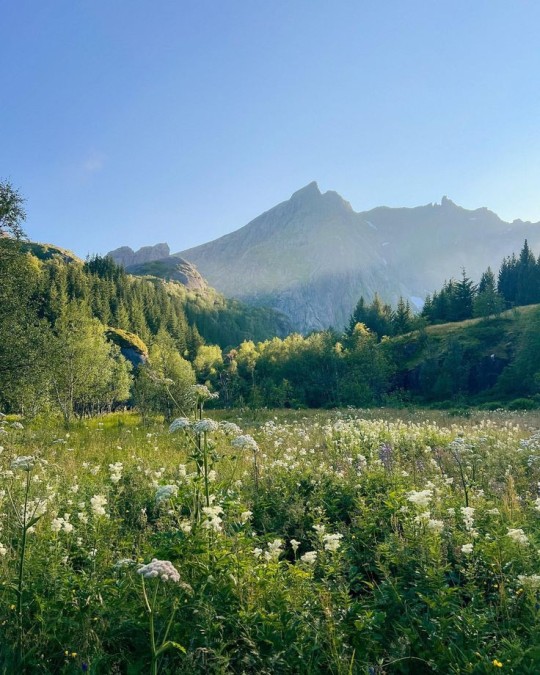


Introduction: Namaste People! I'm brown , this post is quite different from others because this post is about spiritual wisdom which is needed a lot in life and without it we are always steps behind achieving what we need . I'm making this post In order to help out and share my wisdom with others to help them improve in their life !
Topic : The state of non-thinking
Overview : The majority of our problems arises due to thinking - a cause of suffering. We have forgotten and undervalued the core importance of quitetiude that's intrisic to our nature and life which has now caused serious problems around and in world and us - disappointment, regret , fight , war, hate , and more. We make the world so let's silence ourself first so we can create a difference altogether with the state of non thinking .
✧ What is it ?
The state of non-thinking refers to where are living in the present without worrying and thinking about the future and past rather in content with what is in front of us totally. It's like an acceptance and way ahead to understand yourself deeply and so your life and take actions accordingly. It's not totally about to stop thinking but rather thinking less.
✧ Why do we need it ?
The majority of the problem arises from our thinking, we can feel negativity only when we think , so wouldn't it be better of without thinking ? For example - You are going to have an exam tomorrow and you haven't prepared yet left with time if used could help out only if you stop thinking about the time and exam continously. Well there it is that positive state which will come out from you and intutive whispers helping you out to do what needs to be done . Hence when you follow that state of non-thinking you allow intuition to work in and connect with your innate natural state . When you practicse the non-thinking consistently you will see connecting with the truth and find answers to all your questions and so you find peace in your life too .
✧ Do we need to completely stop thinking ?
Well , it depends on what kind of life you want to live or what purpose you hold and how you want to change your life accordingly. In terms of survival we do need negative thinking to make us aware and alert . Therefore we may go to less thinking than to non-thinking and with consistent practisce you shall be able to maintain lesser thinking and non thinking for same .
✧ Is thought and thinking the same ?
No , they are completely different . The thought is divine and thinking is the cause of suffering from your head .
✧ How do I come to the state of non-thinking ?
You can do certain things :
1. Realise that thinking is the cause of suffering.
2. Eliminate that makes you prone to think like actions and things which do not inspire and excite you at all .
3. Create an environment and in your day that would help you come back in the state again. So when you wake up early in the morning keep your device aside and mediate .

©️ @theladybrownstarot 2023 all rights reserved. Any stealing or copying of work will be a punishable offence.
#theladybrownstarot#tarot community#free tarot#tarot reading#tarotblr#pac#tarotscope#astro community#tarot witch#pick a card#pick a photo#pickup#pick a picture#pick one#pick a pile#mental health#holisticwellness#spirituality#witch community#witchcore#witches#witchcraft#witch#witchblr#astro observations#tarot and astrology#sanatandharma
99 notes
·
View notes
Text
Sleep Token is being turned into a brand rather than a band and being commercialised to a point where it will harm them more than help them
An opinion on there being too much ST merch
Befofe starting this, i want to clear up a few things
I am aware that Vessel and ii probably have very little responsibility/say in this and it's the management/rca who is doing this
Yes, i am a fan and i support them. However, it is unhealthy and not good to blindly support every decision and action of your favourite artist, person etc without questioning them and holding them accountable
I know that earning money with music in times of streaming is hard/impossible but that does not justify those moves of tryihg to get as much money as possible out of them
This also applies to other bands, but the extent to which this aapplies to ST is extreme compared to others
We are one week into this year and there has already been a new merch drop. After 6 days. You know when the last one was? Less than a month ago. Same merch shop (US). The items? Some of them questionable (flannels??). The leather jacket? Insane (not in a good way). It looks okay but you could make one yourself and make it look way cooler and get it for less money as one of my tumblr moots said.
I remember last year up until July/August it kind of was a running joke in the fandom about the emails with obtain and how we're too broke to obtain, but now? This is not a joke anymore. Ever since last year we have gotten emails ALMOST EVERY MONTH, sometimes even several times a month about new merch releases.
Yes, there are different stores worldwide, but we live in a time of international shipping. And even for one store it's lots of releases. Plus then there's all the licensed products shops like Hot Topic, Impericon, EMP and whatever their local equivalents are, who also constantly release more merch.
What's even worse: a lot of those things are either a shitty quality (if i remember right, one of the hoodies or tshirts from the EU tour 2024 had the print peeling off after one wash) and/or really bland. Where is the cool art, the thing that makes these items special? I got a tshirt from the German Rituals 2023 with this sick artwork on it that i cherish more than anything. But compared to that most tour merch of the more recent tours has been nothing special.
Most of them just have the logo on it and it reminds me of any ither fashion brand. There's only so many jumpers and t-hsirts and sweatshirts with the logo that a person needs and the constant release of new but actually the same stuff is creating this insane overconsumption which harms fans' bank accounts and the environment and is straight up boring. There's nothing about them that makes them special and unique and cool. It feels like at this point it is a contest of how many ST logos can they plaster on an item before it looks ridiculous (on the leather jacket i counted at least four, three of them massive).
Which brings me to the next point. People just slap on a ST logo because the band is so hyped and to make money off it or get more clicks, even if it is only remotely related to them. I understand that in today's world you need to use buzzwords to make people pay attention, but with ST it has reached the most ridiculous level. The air of anticipation some magazines or brands build around some upcoming stuff with words like Worship and whatever, which everyone connects to ST, just to reveal a mid product or result is just horrible and will eventually make it less effective which can harm the band in the long run if they can't build up excitement for new releases as much as they could because everyone is 'burnt out' because it's been overused.
Overall, this insane amount of merch and using ST to sell anything or get clicks is not okay. The fan base is so dedicated and loyal and we deserve better than to be - for the lack of a better word - exploited like this just because we like and support an artist. Prices for everything have been rising for years and it's hard for a lot of us financially. We spend so much money on concerts already and then the ton of merch and everything on top is just too much. ST as a brand is used to exploit fans which is not how you should treat your fans (again want to emphasise that this is mostly on management and label, not Vessel)
You might think 'But you don't have to go to concerts or buy their merch'. That's right, you don't. But concerts are kind of the thing when you're a fan of a band, and you want to support your fave band abd wear merch and show that you like them. However, the merch and everything is limited and posed in a way that creates FOMO and everyone is always drilled to Consume and Obtain (yes that's how capitalism works and that is not good in this situation because it harms us fans so much.) I can't deny I've given in to this as well twice during the EU shows and i am now left with an underwhelming sweatshirt and a hat that i never really needed and probably wouldn't have bought if i hadn't been in this mindset so much.
'Oh but i want to support Vessel and the band.' Yes, merch does help out artists, especially in times of streaming. But how much do you think they make? Merch is using little to no lyrics or song related things that the band could earn money off due to copyright. And i don't know who owns the right to the logo (i did some research and found someone in management with three trademarks on something ST related but it never specified if that applies to just the name or the logo or the music or whatever - it was not Vessel though). Who knows how much is going to management and the label and how much the band actually earns. Right now it feels like the management and label want to make as much money possible from them for their own gain. As an alternative to support them, start buying their albums and vinyls so they earn more money off their songs.
So, what do i want? Obviously i don't want fans to stop buying merch because it does help artists to some degree. However, I want less merch releases, one or maximum two a year per merch store (so AUS, US and UK/EU). We can have a few simple designs with the logo on it, but i also want some cool pieces with art or something else that makes them special. I know artists are expensive and stuff, but that's why you make less items but higher quality. Make them available in larger quantities so that more people can buy them and they will still get their money. Plus you always have extra tour merch, which is another extra release. Make the merch special again and make it mean something to people instead of just being another logo like a fashion brand.
If they continue like this fans will eventually be unable to afford stuff, people will turn away from merch because they realise it's all the same, and the effect of using ST as a brand/connection simply to sell stuff will harm their reputation (it already is). Whoever is responsible for this merch insanity needs to put a stop to it. Please!
This is just my opinion. Disagree if you want to. Some things, especially the effects of the situation, are portrayed slightly exaggerated, but this is how it makes me feel and I truly believe this is not a great situation we're in right now with the merch.
(Not taking any responsibility for typos)
#sorry about this essay but this just needed to be said#stop turning bands into brands to make money off them#sleep token#personal rant#anyway just my opinion
67 notes
·
View notes